Want to know the secret of growing an abundance of tasty pineapples at home? The “trick” is to save the tops and follow the instructions in our simple guide.
Pineapples are easy to grow. You can use the tops from fruits you bought at the store or the slips and suckers from the main plant.
However, they can take a long time to produce and would require some patience. Thankfully, they don’t need too much attention, and the tasty rewards are well worth waiting for.
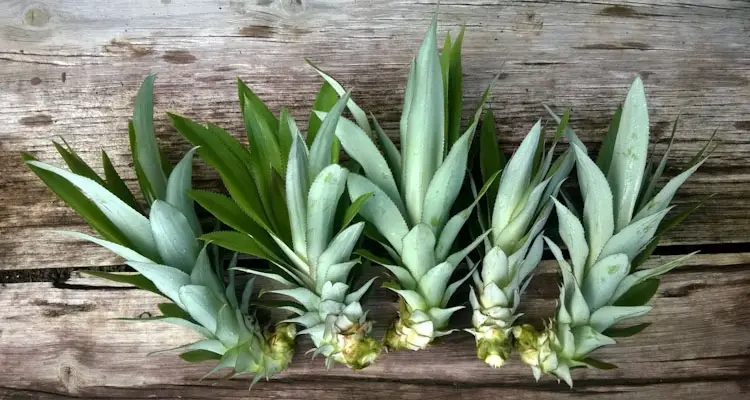
Now, before we get ahead of ourselves, let’s take a look at the 5 simple steps to grow pineapples at home and an easy way to tell when they are ripe and ready to harvest.
Let’s get started!
See Also: Is Pineapple A Fruit Or Edible Flower? Explained With Pictures
Step 1: Collect Planting Materials And Equipment
Growing pineapples at home are easy, but before you get started, you’ll need to have a few items. Initially, I was tempted to list some of these as optional, but please ensure you are careful when handling the plant.
Thankfully, you should already have most of the equipment listed. Either way, here are the materials and equipment you’ll need to grow pineapples.
| Items | Details |
| Pineapple Plantlets | Use either slips or suckers from the plant or crown from the fruit |
| Sharps Knife | To cut the top from pineapple |
| Garden Gloves | To safely handle pineapple leaves |
| Pliers | To remove unwanted leaves |
| Large Container | To propagate planting material |
| Compost | It will help add nutrients and microbes to the soil while suppressing weeds. |
| Garden Hand Tools | Hand Shovel, Hand Fork, |
| Nursery Pot (Optional) | At least 6 inches in width and height |
| Potting Mix | Well-drained planting medium |
| Watering Can Or Hose | To irrigate and apply fertilizer |
| Safety Goggles (Optional) | To protect your eyes from thorns |
| Large Planting Pots (Optional) | To grow plants to maturity in a container |
Note: Pineapple leaves are sharp and can injure you if mishandled. Please wear protective gear and be careful when handling the planting material.
Step 2: Trim And Prepare Slips, Crowns, Or Suckers
Regardless of which part of the plant you use, you should remove unnecessary debris and leaves. Ensure you wear protective clothing and equipment when handling pineapple slips, crowns, or suckers.
To prepare pineapple crowns, cut the top off the fruit and remove the excess flesh from it. Then use a pair of pliers, or gloves, to carefully remove the smaller leaves. Make a clean cut at the bottom of the crown, just enough to get rid of the excess flesh.
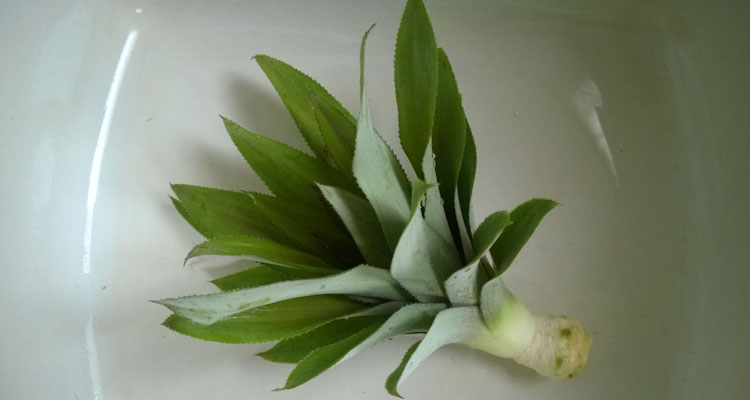
To prepare pineapple suckers and slips, carefully remove them from the plant. Then strip away the small lower leaves. Use a sharp knife or garden shears to make a clean cut where the plant once attached to the stem; only cut enough to straighten the edges.
Note: the roots of the new pineapple plants will emerge from the joints between the lower leaves of the plantlets, so be careful not to cut off too much while straightening the edges.
Step 3: Place Crown In Water And Change Regularly
Once cleaned, place the plantlet into a water container, submerging it about ½ inch. This encourages growth only at this point.
Place the container in a cool, well-lit area that is easy to access. You will need to change the water daily to keep the plant healthy. Alternatively, you can place it into a hydroponic system, but that’s another story.
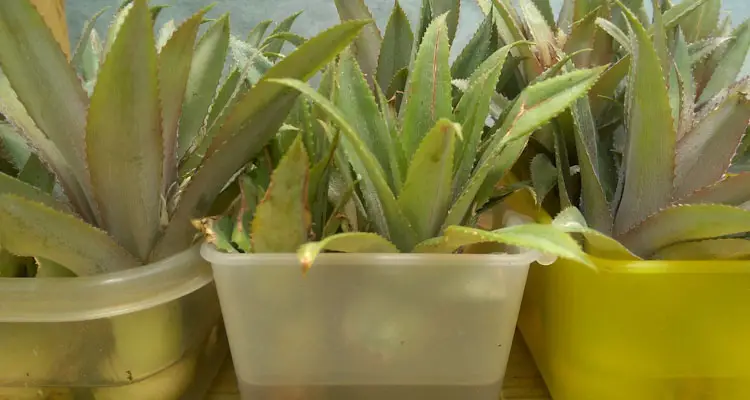
Check the plants weekly for root development, but don’t worry if you don’t see changes in the first couple weeks. The new growth rate can be affected by the variety of the plants and the temperature. Just ensure you keep a fresh supply of water.
Note: My plants took about 2 weeks before noticing some tiny roots. I left the container for another month since I had not prepared the area as yet. This time allowed their roots to develop much more robust and longer.
Step 4: Transplant Rooted Plantlets To Growing Area
Once the plantlets develop a healthy root system, you can transplant them to a well-prepared garden bed or container. Ensure the soil is well-drained, with plenty of organic matter and nutrients.
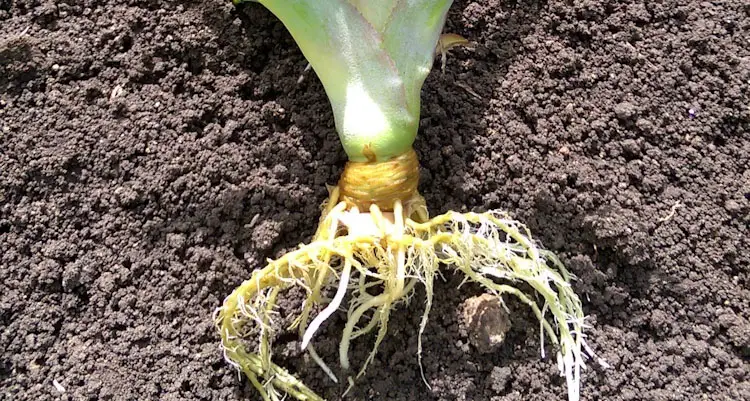
Pineapples are tropical plants and love warm, humid growing conditions. However, contrary to popular belief, they don’t like full sun. They are originally understory plants and thrive in the dappled light of taller trees.
If grown in containers, you can initially transplant the plantlets into a 6″ pot, but be prepared to pot up to a larger container within a few months. Ideally, you can use a 2 to 5-gallon container since the plants can grow large.
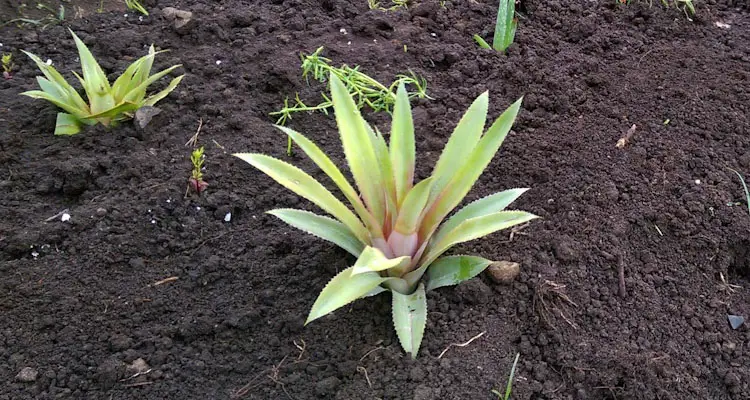
Note: In temperate regions, you may need to expose pineapple to the full sun due to temperature differences. Ideally, these should be grown in containers, which can be moved into the warmer environment during colder periods.
Step 5: Water And Fertilize When Necessary
Pineapple plants don’t need much water. They are drought-tolerant and dislike soggy soils. However, they thrive on a steady supply of moisture. Ideally, you should water pineapples only when necessary. Apply mulch to retain moisture, limiting the need for additional irrigation.
On the other hand, Pineapples are heavy feeders and require lots of nitrogen and potassium. As a result, you will need to provide them with an ongoing supply of organic materials or fertilizer throughout their growing season.
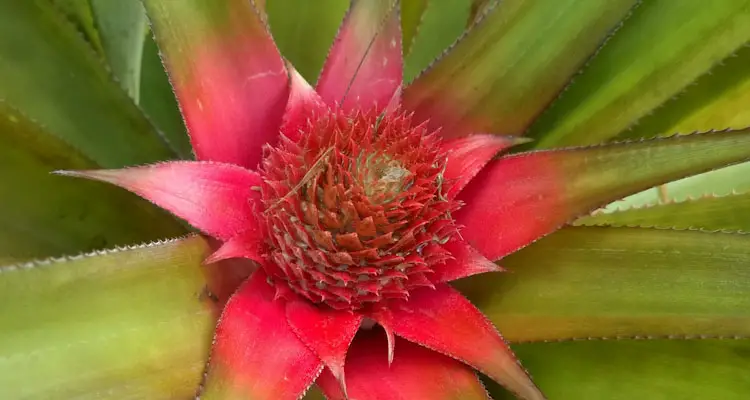
It is much easier to apply organic liquid fertilizer due to the thorny leaves of the plant. You can use a very dilute solution every other week, especially after heavy rains, to ensure the plant has what it requires.
See Also: How To Make Jadam Liquid Fertilizer
How Long Does Pineapple Take To Be Ready?
In ideal growing conditions, most pineapples can produce their first fruit within one year but can take up to three years to be ready. However, the subsequent fruits produced by the suckers will take a shorter time to mature.
As a result, you should provide the best possible growing conditions, but be patient since the exact time of maturity can vary considerably.
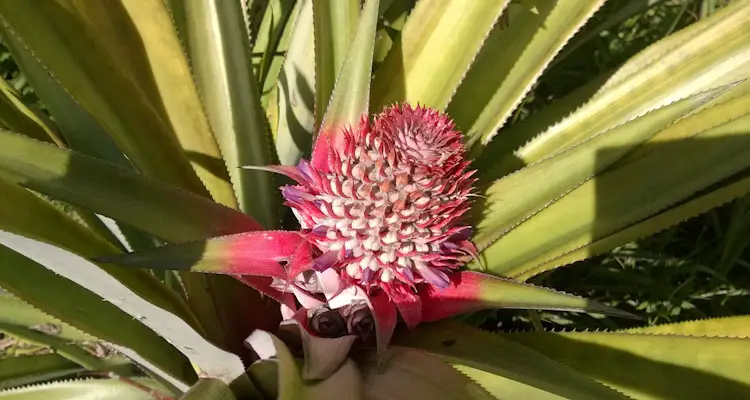
Alternatively, you can choose varieties known to bear fruit quickly. However, this is not foolproof. For example, the pineapple slip I planted took about three years before harvest but came from a plant that generally produces in less than a year.
How To Tell When Pineapple Is Ripe?
Using your senses is the simplest way to tell when a pineapple is ripe. In the early stages, the firm, dark-green skin changes color, gradually spreading until the whole fruit is yellow.
A fully ripe pineapple has firm, yellow skin with an unmistakable fruity scent, which carries on the wind and quickly fills an enclosed room. However, the appearance may differ slightly based on the variety, but the smell is undeniable.
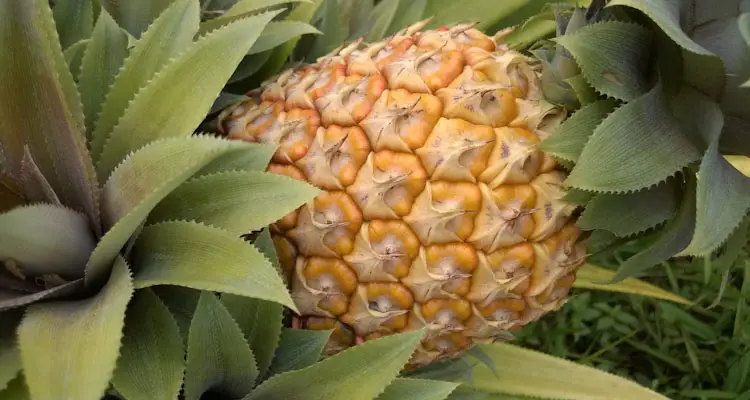
Most pineapples sold at the supermarket are picked when mature and allowed to ripen on the shelf. As a result, the aroma may not yet be as noticeable, but you should look for hints of color change and firmness.
How To Harvest Pineapple?
To harvest pineapples, use pruning shears or a sharp knife to cut the stalk a few inches below the fruit and slips if present. These thorn-edged leaves are serrated, so be careful and wear the necessary protective gear; gloves and long sleeves.
Pineapple crowns make perfect hiding places for all sorts of creatures. After cutting the fruit from the plant, remove the slips from its base, then submerge them into a bucket of water. You may wish to do this outside your house, just in case.
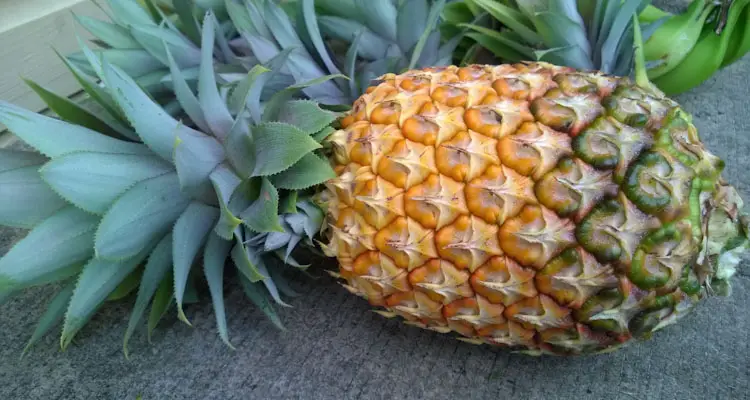
Afterward, allow it to air dry in a cool place and continue to ripen if necessary. Depending on when you picked it or your overall preference, this can take several days. Clean the slips and start preparing them for new planting.
Final Thoughts
Pineapple is one of the easiest tropical fruits to propagate, but it can take a while before it produces fruit. It can be grown in the ground or in containers and requires little attention once established.
In ideal conditions, pineapple is a perennial plant, which can be kept producing for years by routinely pruning unnecessary suckers and replanting them as well as splits and crowns.
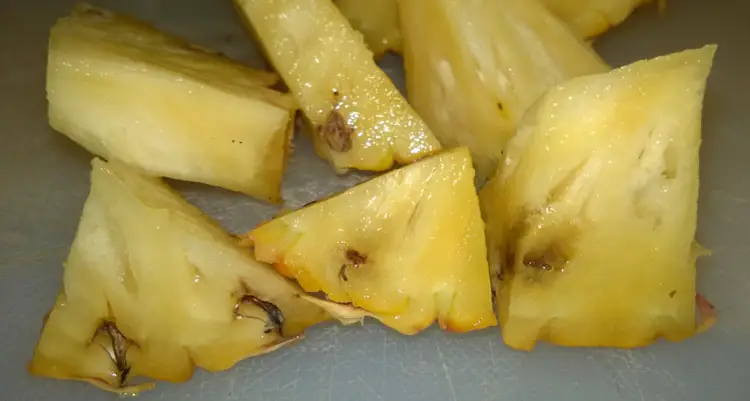
Pineapple is a delight to grow but a potential pain to harvest, requiring extra care in handling, cleaning, and storing. However, if done correctly, you can enjoy the fruits of your labor for years.
Related Questions
Is Pineapple A Fruit?
Pineapple is an edible fruit consisting of several berries fused together, forming a whole. It is often referred to as a multi-fruit with seeds located towards the out part of the skin: remnants of the original cluster of flowers from which the fruit developed.
What Are Pineapple Slips?
Pineapple slips are small crown-like plants that grow at the base of the fruit of some varieties of plants. Each slip can be removed and propagated as new plantlets, resulting in potentially infinite reproduction.
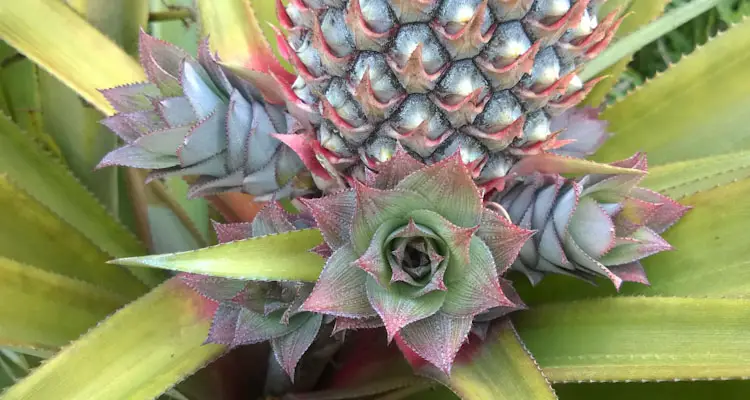
References
IFAS Extension. Pineapple Growing In Florida Home Landscape. edis.ifas.ufl.edu. Accessed July 2022
College Of Tropical Agriculture And Human Resources. Pineapple Cultivation In Hawaii. [PDF]. Accessed July 2022
